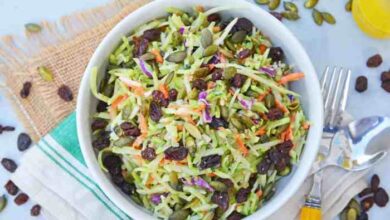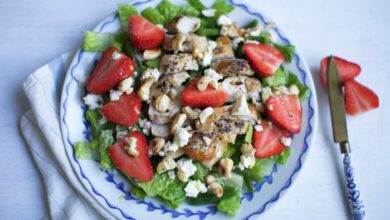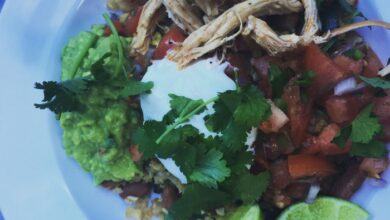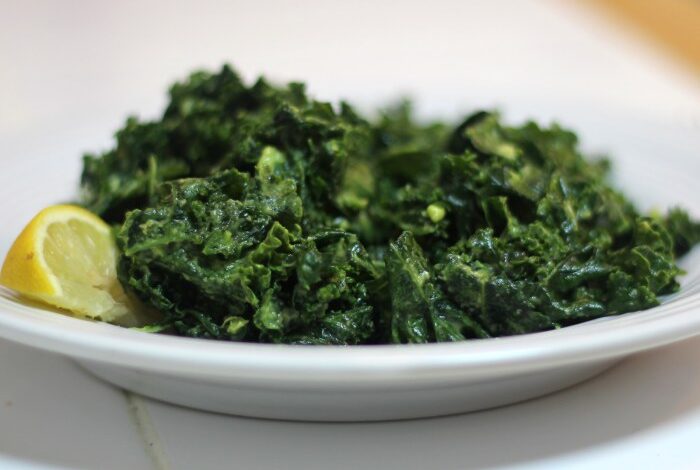
The Best Kale Salad: A Guide to Flavor and Nutrition
The best kale salad isn’t just a healthy choice, it’s a delicious adventure! From classic variations like Caesar and massaged kale to creative concoctions with unique toppings, the world of kale salads is bursting with flavor and possibilities. This guide will delve into the nutritional benefits of kale, explore tips for creating the perfect salad, and share mouthwatering recipes that will have you craving kale like never before.
Whether you’re a kale enthusiast or a newcomer to this leafy green, we’ll equip you with the knowledge and inspiration to craft salads that are as vibrant and satisfying as they are healthy. Get ready to discover the endless potential of kale, and learn how to create your own signature kale salad masterpiece!
Kale Salad Variations
Kale salad is a versatile dish that can be adapted to suit a wide range of tastes and preferences. Its earthy flavor and crunchy texture provide a blank canvas for creative combinations.
Popular Kale Salad Variations
The popularity of kale salad stems from its adaptability and the diverse flavor profiles it can accommodate. Here are 10 popular variations that showcase the versatility of this leafy green:
- Classic Caesar Salad with Kale: This variation combines the familiar flavors of a Caesar salad with the nutritional benefits of kale. It typically features chopped kale, grated Parmesan cheese, croutons, and a creamy Caesar dressing.
- Mediterranean Kale Salad: This variation draws inspiration from Mediterranean cuisine, incorporating ingredients like Kalamata olives, feta cheese, red onion, and cherry tomatoes. The dressing is usually a light vinaigrette with lemon juice, olive oil, and herbs.
- Asian-Inspired Kale Salad: This variation features a combination of Asian-inspired ingredients such as sesame seeds, edamame, chopped peanuts, and a ginger-soy dressing. The addition of a light, tangy dressing complements the earthy flavor of kale.
- Apple and Cranberry Kale Salad: This variation offers a sweet and tangy combination with chopped apples, dried cranberries, and toasted pecans. The dressing is usually a honey-mustard vinaigrette or a balsamic vinaigrette.
- Roasted Sweet Potato and Kale Salad: This variation features roasted sweet potatoes, which add sweetness and a satisfying texture to the salad. The dressing is often a maple-tahini vinaigrette or a simple olive oil and lemon juice dressing.
- Black Bean and Corn Kale Salad: This variation combines black beans, corn, and a zesty lime dressing. The addition of avocado adds creaminess and healthy fats.
- Citrus Kale Salad: This variation features a bright and refreshing combination of citrus fruits like grapefruit, oranges, and tangerines. The dressing is often a simple vinaigrette with olive oil, lemon juice, and honey.
- Kale and Quinoa Salad: This variation features quinoa, which adds protein and fiber to the salad. The dressing is usually a light vinaigrette with lemon juice, olive oil, and herbs.
- Kale and Chickpea Salad: This variation combines chickpeas, which add protein and a satisfying texture. The dressing is often a tahini-based dressing with lemon juice, garlic, and herbs.
- Kale and Avocado Salad: This variation features avocado, which adds creaminess and healthy fats. The dressing is often a simple vinaigrette with olive oil, lemon juice, and salt and pepper.
Dressing Options
The dressing is a key component of any kale salad, as it enhances the flavor and texture of the leafy green. Common dressing options include:
- Vinaigrettes: These dressings are typically made with oil, vinegar, and seasonings. They can be light and tangy or rich and flavorful depending on the ingredients used.
- Creamy Dressings: These dressings are made with mayonnaise, sour cream, or yogurt. They are often used in Caesar salads or other variations that require a creamy texture.
- Tahini-Based Dressings: These dressings are made with tahini, a sesame seed paste. They have a nutty flavor and a creamy texture.
- Honey-Mustard Dressings: These dressings combine the sweetness of honey with the tanginess of mustard. They are often used in salads with fruits or nuts.
- Balsamic Vinaigrettes: These dressings are made with balsamic vinegar, olive oil, and seasonings. They have a sweet and tangy flavor that complements many kale salad variations.
Nutritional Benefits of Kale
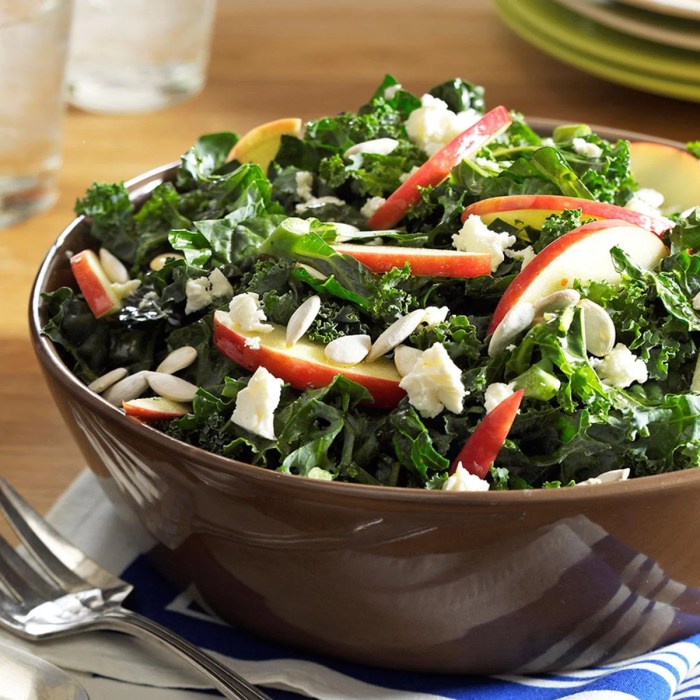
Kale is a leafy green vegetable that has gained immense popularity in recent years due to its exceptional nutritional profile. This cruciferous vegetable, a member of the same family as broccoli and Brussels sprouts, packs a powerful punch of vitamins, minerals, and antioxidants, making it a superfood that contributes significantly to overall health and well-being.
Nutritional Value of Kale
Kale is an excellent source of essential nutrients. It is particularly rich in vitamins A, C, and K, as well as minerals like calcium, potassium, and iron.
- A single cup of cooked kale provides approximately 68 calories, 3 grams of protein, and 6 grams of carbohydrates. It is also a good source of fiber, which aids in digestion and helps regulate blood sugar levels.
- Kale is an excellent source of vitamin A, with one cup providing more than 200% of the daily recommended value. Vitamin A is crucial for healthy vision, skin, and immune function.
- Kale is a rich source of vitamin C, an antioxidant that protects cells from damage and boosts the immune system. One cup of cooked kale provides around 80% of the daily recommended value of vitamin C.
- Kale is an excellent source of vitamin K, which plays a vital role in blood clotting and bone health. One cup of cooked kale provides more than 1000% of the daily recommended value of vitamin K.
- Kale is also a good source of calcium, a mineral essential for strong bones and teeth. One cup of cooked kale provides around 10% of the daily recommended value of calcium.
- Kale is a good source of potassium, a mineral that helps regulate blood pressure and muscle function. One cup of cooked kale provides around 9% of the daily recommended value of potassium.
- Kale is a good source of iron, a mineral essential for red blood cell production. One cup of cooked kale provides around 6% of the daily recommended value of iron.
Health Benefits of Consuming Kale
The abundance of nutrients in kale contributes to a wide range of health benefits, including:
- Improved Eye Health:Kale is rich in vitamin A, a nutrient essential for maintaining good vision and preventing age-related macular degeneration.
- Enhanced Immune Function:Kale is a good source of vitamin C, which boosts the immune system and protects against infections. The antioxidants in kale also help combat oxidative stress, which can damage cells and contribute to disease.
- Stronger Bones:Kale is an excellent source of vitamin K and calcium, both essential for bone health. Vitamin K helps regulate bone metabolism, while calcium is the building block of bones.
- Reduced Risk of Chronic Diseases:The antioxidants in kale have been linked to a reduced risk of chronic diseases such as heart disease, cancer, and type 2 diabetes. The fiber in kale also helps regulate blood sugar levels, reducing the risk of type 2 diabetes.
- Improved Digestion:The fiber in kale aids in digestion and promotes regularity. It also helps feed the good bacteria in the gut, contributing to a healthy digestive system.
- Weight Management:Kale is low in calories and high in fiber, making it a filling and satisfying food that can help with weight management. Its high nutrient density also provides essential vitamins and minerals without adding unnecessary calories.
Role of Kale in a Balanced Diet
Kale is a versatile vegetable that can be incorporated into a variety of dishes, making it easy to include in a balanced diet. It can be added to salads, smoothies, soups, stir-fries, and even baked goods. Its mild flavor allows it to blend well with various ingredients, making it a delicious and nutritious addition to any meal.
The best kale salad is all about balance – a mix of textures, flavors, and colors. It’s like a symphony on your plate! And just like a good symphony needs a strong opening, my day starts with a powerful breakfast.
I swear by this quick strawberry oatmeal breakfast smoothie to fuel my morning, and then I’m ready to tackle that kale salad masterpiece!
A balanced diet should include a variety of fruits, vegetables, whole grains, lean protein, and healthy fats. Kale can play a significant role in achieving a balanced diet by providing essential nutrients and contributing to overall health and well-being.
Tips for Making the Best Kale Salad
A good kale salad is a delightful combination of fresh, vibrant flavors and textures. It’s a healthy and satisfying dish that can be enjoyed as a light lunch, a side dish, or even a hearty main course. To ensure you create the perfect kale salad, follow these tips.
The best kale salad is all about balance – the peppery bite of kale, the creamy richness of dressing, and the textural contrast of crunchy toppings. But sometimes, you want something a little more substantial, like these grilled asparagus steak bundles.
They’re a perfect pairing for a kale salad, providing a satisfying protein and smoky char that complements the salad’s freshness.
Selecting Fresh Kale, The best kale salad
Choosing fresh kale is crucial for a delicious salad. Look for kale with bright green leaves that are firm and crisp. Avoid any wilted, yellowed, or damaged leaves. Here’s how to identify the best kale:
- Check for vibrant color:Fresh kale has deep green leaves that are free from any yellowing or browning.
- Feel for firmness:The leaves should be firm and crisp to the touch, not limp or soft.
- Inspect for damage:Avoid kale with any holes, tears, or signs of insect damage.
Preparing Kale for Salads
Once you have selected your kale, proper preparation is essential to ensure a pleasant eating experience. Here are some tips for preparing kale for salads:
- Wash thoroughly:Rinse the kale thoroughly under cold water to remove any dirt or debris.
- Remove tough stems:The stems of kale can be tough, so it’s best to remove them before using the leaves in a salad. Use a sharp knife to cut the stems off, leaving just the tender leaves.
- Chop or tear:You can either chop the kale into bite-sized pieces or tear the leaves into smaller pieces.
Massaging Kale
Massaging kale is a key step in preparing it for salads. It helps to soften the leaves and make them more tender.
You know what pairs perfectly with the best kale salad? A hearty and flavorful main course, like this Mexican-inspired chicken thigh and rice skillet. The smoky spices and tangy flavors of the chicken and rice complement the earthy crunch of the kale salad beautifully.
It’s a match made in culinary heaven!
- Use your hands:Place the chopped or torn kale in a large bowl and use your hands to gently massage the leaves with a drizzle of olive oil or lemon juice. This helps to break down the tough fibers in the kale and release its natural flavors.
- Massage for a few minutes:Continue massaging the kale for a few minutes until the leaves become slightly wilted and more pliable.
- Add salt and pepper:After massaging, season the kale with salt and pepper to taste.
Dressing-to-Kale Ratio
The ideal dressing-to-kale ratio is important for a balanced and flavorful salad.
- Start with a small amount:Begin by adding a small amount of dressing to the kale, just enough to lightly coat the leaves.
- Taste and adjust:Taste the salad and add more dressing as needed. The goal is to have enough dressing to flavor the kale without making it soggy.
- Consider the type of dressing:Thicker dressings, like creamy dressings, may require less than lighter dressings, like vinaigrette.
Creative Kale Salad Toppings
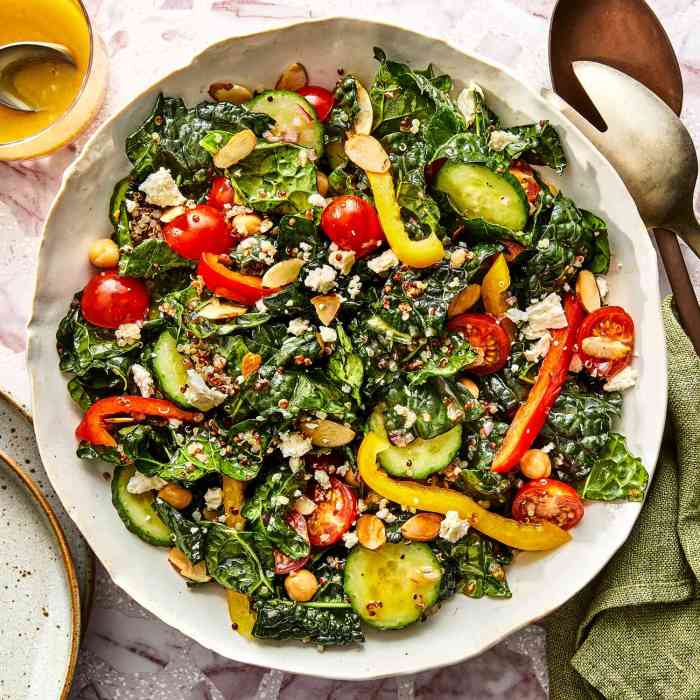
The foundation of a great kale salad is, of course, the kale itself. But what truly elevates it to deliciousness are the toppings. Think beyond the usual nuts, seeds, and dried cranberries. Here’s a journey into the world of creative and flavorful kale salad toppings that will surprise and delight your taste buds.
Creative Kale Salad Toppings
Toppings can add a multitude of flavors, textures, and nutritional benefits to your kale salad. Here’s a table showcasing a variety of options:
| Toppings | Flavor Profile | Texture | Nutritional Benefits |
|---|---|---|---|
| Roasted Sweet Potatoes | Sweet, Earthy | Soft, Tender | Rich in Vitamin A, Fiber, Potassium |
| Grilled Pineapple | Sweet, Tangy | Juicy, Slightly Firm | Source of Vitamin C, Manganese, Bromelain |
| Pickled Red Onions | Tangy, Spicy | Crunchy, Sharp | Antioxidant Rich, Low in Calories |
| Crispy Chickpeas | Nutty, Savory | Crunchy, Light | High in Protein, Fiber, Iron |
| Roasted Beets | Sweet, Earthy | Soft, Tender | Rich in Vitamin C, Fiber, Nitrates |
| Mango Chunks | Sweet, Tropical | Juicy, Soft | High in Vitamin C, Fiber, Potassium |
| Avocado Slices | Creamy, Nutty | Smooth, Soft | Rich in Healthy Fats, Fiber, Potassium |
| Fresh Herbs | Fresh, Aromatic | Soft, Fragrant | Rich in Vitamins, Minerals, Antioxidants |
| Dried Apricots | Sweet, Fruity | Chewy, Soft | Good Source of Fiber, Vitamin A, Potassium |
| Toasted Almonds | Nutty, Creamy | Crunchy, Light | High in Vitamin E, Fiber, Magnesium |
| Feta Cheese Crumbles | Salty, Tangy | Crumbly, Soft | Good Source of Calcium, Protein, Vitamin B12 |
| Pomegranate Seeds | Tart, Sweet | Juicy, Crunchy | Rich in Antioxidants, Fiber, Vitamin C |
| Watercress | Peppery, Slightly Bitter | Crunchy, Delicate | High in Vitamins A, C, K |
| Radishes | Peppery, Spicy | Crunchy, Sharp | Rich in Vitamin C, Fiber, Antioxidants |
| Caramelized Onions | Sweet, Savory | Soft, Tender | Good Source of Antioxidants, Fiber, Potassium |
These toppings can be combined in countless ways, allowing you to create unique and delicious kale salad combinations. For instance, the sweetness of roasted sweet potatoes pairs beautifully with the tangy crunch of pickled red onions, while the creamy avocado complements the nutty flavor of toasted almonds.
The possibilities are endless!
Kale Salad Recipes: The Best Kale Salad
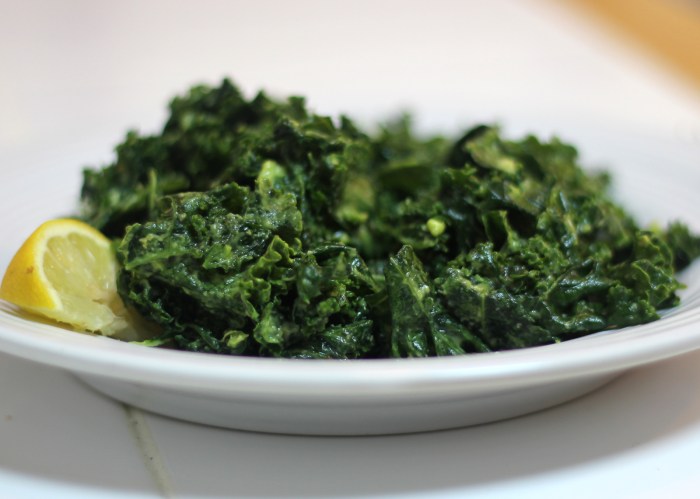
Now that you’ve learned about the benefits and tips for creating the perfect kale salad, let’s dive into some delicious and unique recipes. These recipes showcase different flavor profiles, from tangy and citrusy to savory and nutty, and can be customized to your liking.
Kale Salad Recipes with Different Flavor Profiles
These recipes are designed to inspire you and offer a starting point for creating your own signature kale salad.
Citrus and Herb Kale Salad
This salad is bright, refreshing, and bursting with flavor. The combination of citrus fruits, herbs, and a tangy vinaigrette makes it a perfect choice for a light lunch or dinner.* Ingredients:
1 bunch kale, washed and torn into bite-sized pieces
1/2 cup orange segments
1/4 cup grapefruit segments
1/4 cup fresh parsley, chopped
1/4 cup fresh mint, chopped
1/4 cup crumbled feta cheese
1/4 cup toasted almonds
Vinaigrette
1/4 cup olive oil
2 tablespoons lemon juice
1 tablespoon honey
1 teaspoon Dijon mustard
Salt and pepper to taste
* Instructions:1. In a large bowl, combine the kale, orange segments, grapefruit segments, parsley, and mint. 2. In a small bowl, whisk together the vinaigrette ingredients until emulsified. 3.
Pour the vinaigrette over the salad and toss to coat. 4. Top with feta cheese and toasted almonds.* Customization Tips:
Add other citrus fruits like tangerines or mandarins.
Substitute feta cheese with goat cheese or Parmesan.
Use a different type of nut, such as walnuts or pecans.
Add a sprinkle of red pepper flakes for a touch of heat.
Creamy Sesame Kale Salad
This salad offers a unique flavor profile with a creamy sesame dressing that complements the kale perfectly. The addition of avocado and edamame adds a healthy dose of fats and protein.* Ingredients:
1 bunch kale, washed and torn into bite-sized pieces
1 ripe avocado, diced
1/2 cup edamame, shelled
1/4 cup toasted sesame seeds
Creamy Sesame Dressing
1/4 cup tahini
1/4 cup soy sauce
2 tablespoons rice vinegar
1 tablespoon honey
1 tablespoon sesame oil
1 clove garlic, minced
1/4 cup water
Salt and pepper to taste
* Instructions:1. In a large bowl, combine the kale, avocado, edamame, and sesame seeds. 2. In a blender, combine all the dressing ingredients and blend until smooth. 3.
Pour the dressing over the salad and toss to coat.* Customization Tips:
Add a pinch of red pepper flakes to the dressing for a spicy kick.
Top the salad with crispy tofu or tempeh for extra protein.
Use a different type of nut, such as peanuts or cashews.
Spicy Kale Salad with Roasted Vegetables
This salad is hearty and satisfying, with a blend of roasted vegetables and a spicy vinaigrette. The roasted vegetables bring out a smoky flavor, while the vinaigrette adds a touch of heat.* Ingredients:
1 bunch kale, washed and torn into bite-sized pieces
1 cup broccoli florets
1 cup Brussels sprouts, halved
1 red bell pepper, sliced
1 yellow bell pepper, sliced
1/4 cup olive oil
1 teaspoon smoked paprika
1/2 teaspoon chili powder
Salt and pepper to taste
Vinaigrette
1/4 cup olive oil
2 tablespoons red wine vinegar
1 tablespoon honey
1 teaspoon Dijon mustard
1/2 teaspoon sriracha
Salt and pepper to taste
* Instructions:1. Preheat oven to 400°F (200°C). 2. In a large bowl, toss the broccoli, Brussels sprouts, red bell pepper, and yellow bell pepper with olive oil, smoked paprika, chili powder, salt, and pepper. 3.
Spread the vegetables in a single layer on a baking sheet and roast for 20-25 minutes, or until tender and slightly charred. 4. While the vegetables are roasting, whisk together the vinaigrette ingredients in a small bowl.
5. Once the vegetables are cooked, add them to the kale and toss to coat. 6. Pour the vinaigrette over the salad and toss to coat.* Customization Tips:
Use different roasted vegetables, such as carrots, sweet potatoes, or zucchini.
Adjust the amount of sriracha to your desired level of heat.
Top the salad with crumbled bacon or toasted walnuts for extra flavor and texture.


